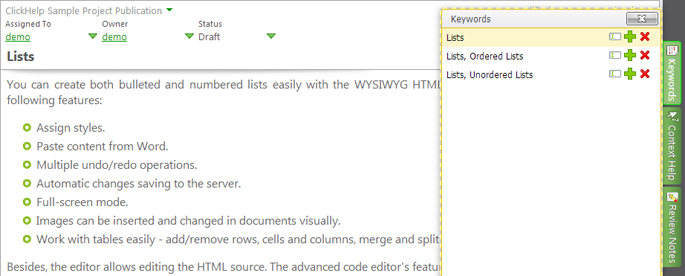
This is a continuation of a blog post series on the SEO aspect of technical writing.
First of all, the “keyword” attribute for the Meta element is designed specially for Search Engines. For example, <meta name=”keywords” content=”technical writing tool, documentation tool”/> informs Search Engines, that this webpage contains information about tools for technical writing and documentation authoring. But most SE don’t consider it nowadays. In particular, Google doesn’t consider it since September 2009.
Another purpose of meta attribute is to help users find some materials grouped by one theme. It makes navigation easier. In this case keywords are automatically displayed on some block on webpage. It’s the main purpose of keywords today.
When you publish your online documentation with ClickHelp, you get the Keywords meta tag created automatically for all help topics. For the tag contents, ClickHelp uses the Index entries assigned to this topic. Those entries are specified in the Keywords panel of the topic editor:

So, when setting up your Keywords for a help topic, you are getting two good things: the Index tab will use them for easier navigation, and the ClickHelp SEO engine will use them for the Keywords meta tag. Take into account that many users of online documentation say that Index is a must have function in documentation – they use it instead of Search in most cases. This means that this is a good idea to specify keywords for your help topics – ClickHelp will create the Index list automatically.
If you like this post, you can find the first and the second articles of this blog post series here: Part 1 – Human-Readable URLs and Part 2 – Crawler-Friendly Pages.
To check out other nice documentation authoring functions of ClickHelp, request a free trial here: ClickHelp Free Trial.
Happy Technical Writing!
ClickHelp Team
